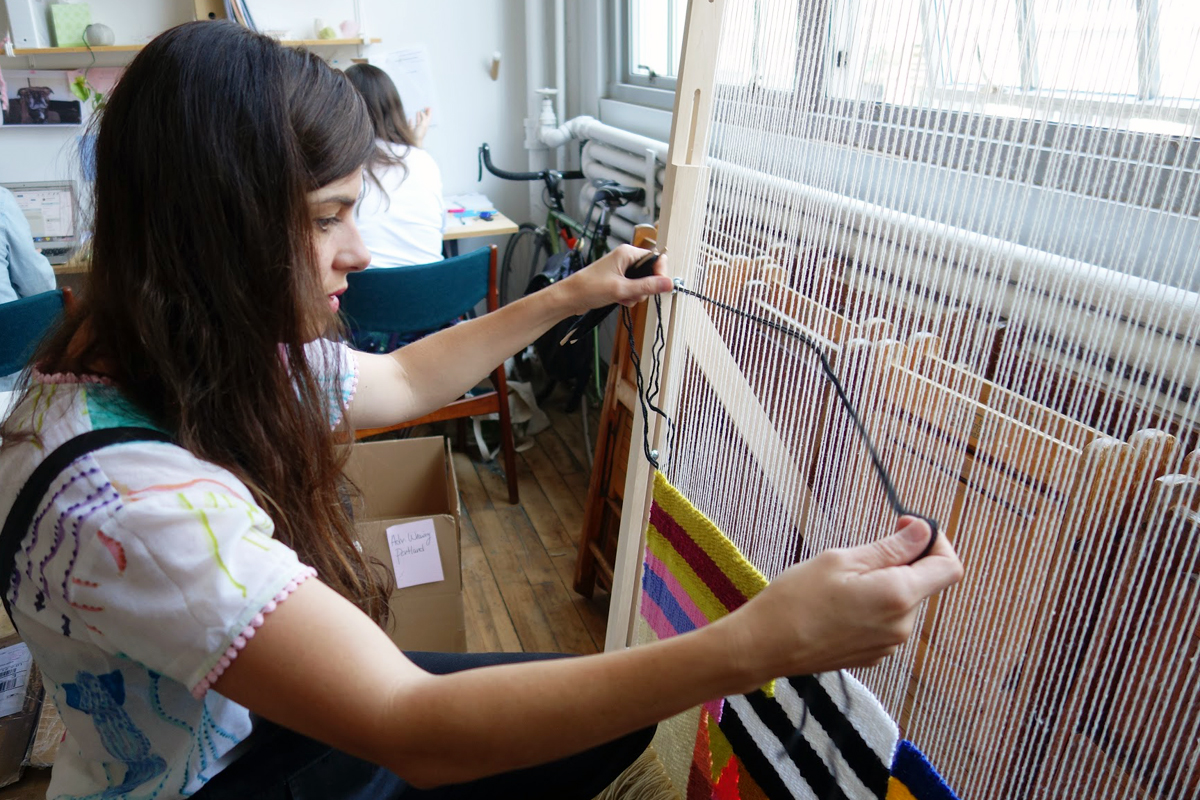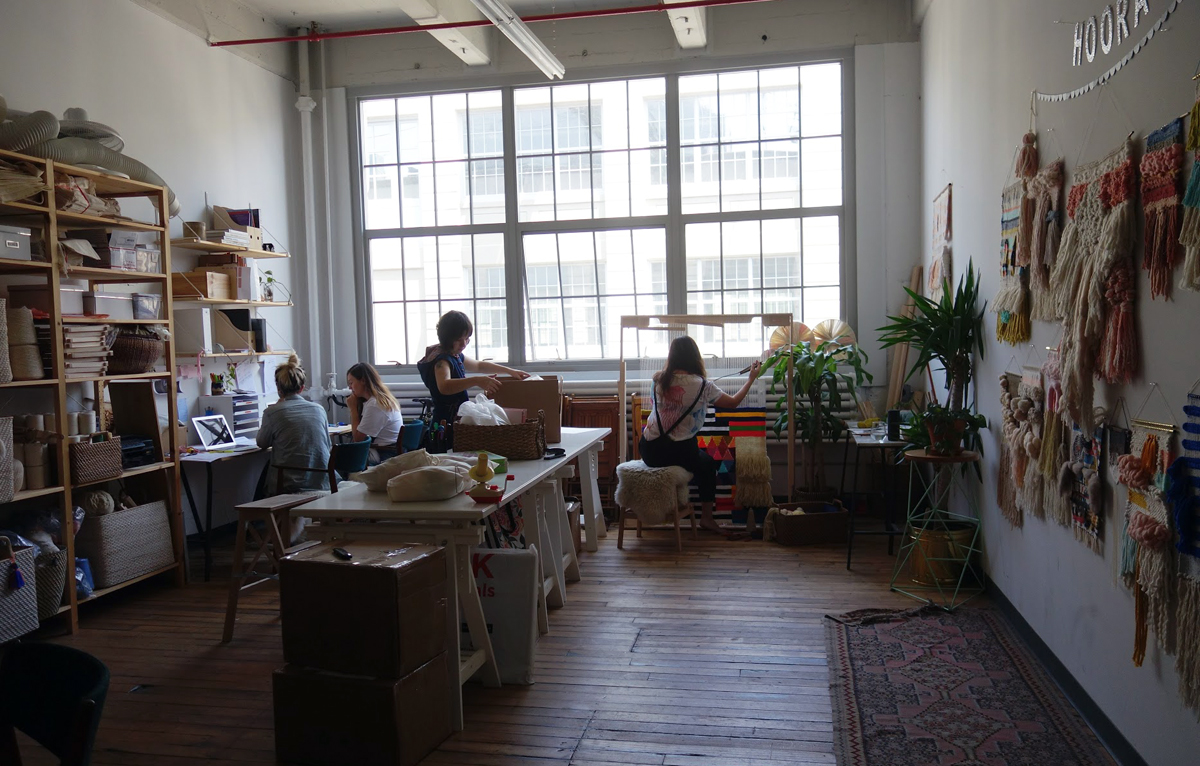Studio Visit: Maryanne Moodie
We learn more about the Brooklyn-based, Australian-born teacher-turned-weaver’s process and how emotion fuels her creations

Three years ago Australian art teacher-turned-weaver Maryanne Moodie packed up her loom and moved to New York City with her husband and newborn baby to give a go at conquering the concrete jungle. That turned out to be a sound decision; the fast-paced metropolis has provided a larger network of like-minded creatives and wider visibility of her work, which takes the form of woven wall hangings. But it also exposed some unexpected feelings of confinement, which Moodie used as artistic fuel.
As we learned on a recent visit to her Brooklyn studio, emotion is the driving force behind each of her works. “My first pieces were very, very colorful; really bright. I had just found weaving and I was so excited,” she says, in contrast to the mostly gray pieces she made after moving to New York. Using the loom as her therapist, she continues to manifest both her talent and (typically positive) sentiments through thoughtful designs.

What inspired you to start weaving?
I’ve always had lots of things on at the same time. Even while I was teaching I had a vintage clothing company, so I had some followers from that who were into the same aesthetic as me. As I was cleaning out the art storage room when I was going on maternity leave, I found a loom and it looked vintage-y, and like I could make things. There was nowhere to find the information (back then Google didn’t have the kind of weaving that I was looking for), so I started learning from vintage books. I think because my followers were already into vintage clothes and homewares, when I started sharing what I was making they were all just like, ‘Yes! This all makes sense; I can follow through the story.”
You recently collaborated with Arro Home.
Yeah! So this year has been really cool because I’ve worked with them by doing what I do, and just being really community focused and open with my process I’ve had these opportunities that I just wouldn’t have had, and I’ve had the time to take them as well. So one of them was designing the [Arro Home] rugs, and they’re great. They’re just like, ‘We love what you do, make us some samples and we’ll get them made up.’ They handle the production because a large rug that I would make on the loom would cost like $10,000—and you wouldn’t want to stand on it! So this is a nice way of opening up the market a little bit more, so people can pay a little bit less but have something in their home the still represents who I am but also Arro is a really cool art brand so it marries the two of us together.

Do you play with different materials?
I play with a lot of vintage yarn I find online or in charity shops. When you’re knitting a jumper you want all the same yarn; you have to be really uniform. [My pieces] are made up of so many different little pieces that if you find second-hand yarn it’s the best. I mix them together—some are vintage, some are hand-spun, some are hand-dyed. It means that my pieces look different to everybody else’s and they look different to my own, which keeps it fresh. There’s a sadness that happens when you finish that precious one that you’re really loving, but at the same time, it’s good for the environment, it’s good financially; there are a lot of benefits to using recycled yarn.
Do you leave in your mistakes?
It depends. When I’m teaching classes I’m like, ‘OK guys, when you have a mistake, just have a think: Can I be inventive? Can I change things around?’ There are good weaving techniques and then there’s also doing it your own way. There was a Kinfolk article about Navajo weavers and how they leave mistakes in their pieces; they allow room for mistakes because they believe that’s where the piece is alive. It shows the human touch. I’m one for leaving mistakes in as long as it doesn’t take away from the structural integrity of the piece. That’s the reason it’s handmade and the reason why someone buys it.

How do you start a piece?
The pieces that I make for clients, I work with them on a color palette or a feeling or emotion, and the area where it’s going to hang. Then I’ll draw up some designs and we’ll work through it to get to a point where I’m not giving up too much of my artistic integrity and they’re also happy with how it’s going to look in their space. But I’m working on my own private art at the same time, to make sure I’m nurturing that side of myself. That’s really important. I start that off by having my sketchbook with me, and by having my eyes open rather than my phone as I’m walking around, allowing myself to feel things.

I’m such a happy person but I was going through sketches that I was doing of [NYC] buildings and brownstones, and the way windows and fire escapes fit together. The first piece that I made from that was this really cramped, small, gray piece. I was like, ‘Oh my god. This is how I’m feeling. I’m feeling squashed!’ The next piece I created was a little lighter in color, but it still had lots of content in there that I still had to unpack before the next one I made, which was a lot more open. I was working through the fact that I may not be able to change the situation of where I am but I can change the way that I see things. It felt like a really positive way of dealing with these negative emotions. I could see the beauty and openness even though I’m in an apartment and taking the subway, jostling with everyone else.

So your designs are more of a manifestation of what you’re feeling.
Yeah, and I love that. Doing my own work feels really important to me. When I’m making pieces for other people, I’m trying to make a connection with them and I’m trying to think about them and whatever the word or emotion they want; do they want a joyful piece or a piece that feels like freedom? I have that inside. But the work I’m making for myself is, yeah, really important. And I feel proud of it.
Maryanne Moodie’s wall hangings can be commissioned via her website, or picked up online at Arro Home which sells their collaborative floor rugs. Keep an eye out for her forthcoming book.
Images by Karen Day












